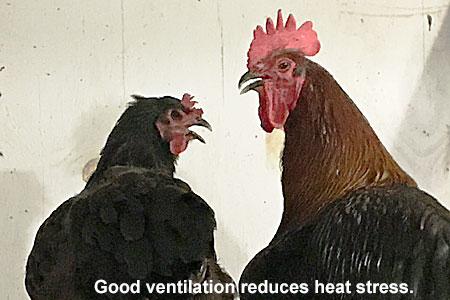
Good ventilation in a chicken coop brings in fresh air without causing drafty conditions. Ventilation is important for many reasons. So, too, is avoiding drafts. Today we’ll explore the importance of coop ventilation, as well as how to determine whether your coop is too drafty or well ventilated.
Reasons for Good Ventilation
A chicken coop needs good ventilation for these important reasons:
- Fresh air dilutes the population of microbes, especially those that cause airborne diseases.
- It also removes suspended dust particles that can cause respiratory issues in chickens.
- Proper air circulation reduces moisture inside the coop.
- Reducing moisture decreases heat stress during warm summer months.
- Reducing moisture helps prevent frostbitten combs and wattles in winter.
- Good ventilation reduces concentrated ammonia fumes in the coop.
Reduce Heat Stress
Moisture tends to be particularly high in a chicken coop. That’s because chickens breathe rapidly. When the temperature exceeds a chicken’s comfort zone, it breathes even more rapidly.
Panting reduces a chicken’s body heat through evaporation. The bird inhales air that’s cooler than its body temperature. The air circulates through the chicken’s respiratory system. The exhaled warm air is laden with moisture.
When panting isn’t enough, the chicken increases evaporation even more by rapidly vibrating its throat muscles. This technique is known as the gular flutter.
As the environmental temperature approaches the chicken’s body temperature of 106°F, moisture also evaporates from its body surface. But air can accept only so much moisture.
If the ambient humidity is already high, the air can’t hold any more. The critical high air temperature is generally considered to be 95°F. However, when the humidity is above 65%, an air temperature of 82°F can be just as uncomfortable for a flock.
Good air circulation inside the coop reduces moisture in the air. It therefore helps chickens avoid heat stress in hot weather.
Avoid Frostbite
The warm air trapped in ruffled feathers helps keep chickens warm in winter. A draft, however, carries away the warm air, causing chickens to feel a chill. But good ventilation is just as important in winter as in summer.
Relative humidity tends to be low in winter months. Still, the air inside a chicken coop can be high in humidity, just from the flock breathing and pooping.
When humidity is high, the air trapped in a chicken’s feathers is damp. So the chicken’s body needs to generate extra heat energy to stay warm. Or, again, the chicken will feel a chill.
Temperatures that are low enough to freeze the moisture in the air can also freeze a chicken’s comb, wattles, and toes. Frostbite is therefore more likely to occur in damp housing than in dry housing.
By reducing moisture in the air, good ventilation without draftiness helps chickens stay warm in winter. It also helps prevent frostbitten combs, wattles, and toes.
To determine if your coop is drafty, hold out a strip of survey tape or tissue paper in the roosting area. If the tape or paper moves while you are holding it still, the coop is too drafty. Good ventilation, unlike a draft, doesn’t necessarily stir up a breeze.
Increasing Air Flow
Ventilation involves a steady air exchange whereby stale air goes out of the coop and fresh air comes in. If moisture accumulates on coop windows, ventilation is inadequate.
One way to ventilate a coop is with windows that can be open all or part way, or be closed, depending on the weather. Another way is to cut air vents in the walls, securely covered with vent registers or hardware cloth. To provide ventilation without draftiness, make sure the vents are higher than the chickens’ roost. A cupola in the coop roof is another option.
Or you may need a fan to move out stale air and bring in fresh air. For a fan that can withstand a coop’s dust and humidity, check a farm store or rural-oriented builder’s supply. Or do a keyword search for “barn fan” or “agricultural fan.”
So how do you know your coop would benefit from a fan? Put on a dusk mask. Then stir up dust by scuffing your foot in the litter. Wait 5 minutes for the dust to settle. Then look at a light beam coming through a window, or use the beam of a strong flashlight to check the air. If dust still hangs in the air, the coop is not adequately ventilated.
As old-timers are fond of saying, “Build your coop tight, and ventilate right.”
And that’s today’s news from the Cackle Coop.
Gail Damerow is author of The Chicken Health Handbook.

